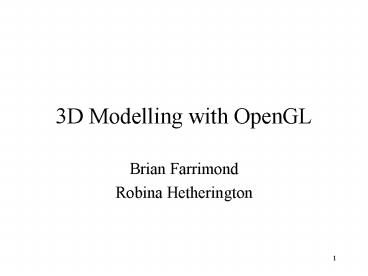3D Modelling with OpenGL - PowerPoint PPT Presentation
1 / 28
Title:
3D Modelling with OpenGL
Description:
... with OpenGL. Brian Farrimond. Robina Hetherington. 2. Schedule. Portfolio work. Week 10. Colour, materials, lighting. Using 3DSMax models. Week 9. 3D OpenGL ... – PowerPoint PPT presentation
Number of Views:105
Avg rating:3.0/5.0
Title: 3D Modelling with OpenGL
1
3D Modelling with OpenGL
- Brian Farrimond
- Robina Hetherington
2
Schedule
3
Todays class
- Programming in C
- Using .NET Visual C
- Compiling Linking Building a program
- C programming with OpenGL
- Computer Graphics
- A first OpenGL program
4
Programming in C
- The Hello world program
- / hello.cpp /
- include ltstdio.hgt
- int main()
- printf(hello, world\n)
- return 0
5
Programming in C
- The Hello world program
- / hello.cpp /
- include ltstdio.hgt
- int main()
- printf(hello, world\n)
- return 0
6
Programming in C
- The Hello world program
- / hello.cpp /
- include ltstdio.hgt
- int main()
- printf(hello, world\n)
- return 0
Include information about the standard library
7
Programming in C
- The Hello world program
- / hello.cpp /
- include ltstdio.hgt
- int main()
- printf(hello, world\n)
- return 0
A C function. Its name is main
A C program consists of a collection of functions
8
Programming in C
- A C function consists of
- a header line
- a body made up of statements enclosed by and
- The Hello world program
- / hello.cpp /
- include ltstdio.hgt
- int main()
- printf(hello, world\n)
- return 0
9
Programming in C
- The Hello world program
- / hello.cpp /
- include ltstdio.hgt
- int main()
- printf(hello, world\n)
- return 0
10
Programming in C
- The Hello world program
- / hello.cpp /
- include ltstdio.hgt
- int main()
- printf(hello, world\n)
- return 0
This is where the program actually starts.
11
Programming in C
- The Hello world program
- / hello.cpp /
- include ltstdio.hgt
- int main()
- printf(hello, world\n)
- return 0
Every C program has a main function
12
Programming in C
- The Hello world program
- / hello.cpp /
- include ltstdio.hgt
- int main()
- printf(hello, world\n)
- return 0
printf is a library function to print characters
13
Programming in C
- The Hello world program
- / hello.cpp /
- include ltstdio.hgt
- int main()
- printf(hello, world\n)
- return 0
Return from the main function i.e. end the
program
14
.NET Visual C
- Microsofts C programming environment
- Program code is placed inside a .NET project
- .NET builds the program (or application) with
this project - We shall build a console application (as opposed
to a Windows application)
15
Using .NET
- Copy the folder
- dotNetExamples\hello
- from the CD to your disc space
- Launch .NET
- Open the hello project using File Open and
navigate to hello.sln inside the hello folder
16
Exploring the hello project
- Solution tree
17
Exploring the hello project
- Solution tree
- Double click on hello.cpp to see the program code
18
Hello.cpp
19
Building the program
- To build the program, select the menu item
- Build Build Solution
20
Running the program
- To run the program, select menu item
- Debug Start
Or use this button
21
Use of getchar()
- Without getchar() the program terminates at once
before we can see what printf has done - getchar() pauses the program until we press the
return key.
22
Exercises
- Modify the text inside the printf statement
- Modify the program so that it prints out
- One
- Two
- Three
23
Building Compiling linking
- Building is a two stage process
- Compiling source code into object code
- Linking object code and library code to produce
the program (known as the executable)
24
More on Building
- See using dotNET IDE in C page 16
25
Separate compilation
- Large programs are made up of many source files
- Each file compiled separately
- Advantages
- Changing the code of one file does not require
recompiling the entire program - Team of programmers can work on different files
26
Multifile example
27
The multifile .NET project
- Copy the folder
- dotNetExamples\multifile
- from the CD to your disc space
- Open the project using
- File Open
- Examine the solution tree
28
The multifile .NET project
- Build and run the program
- Edit func2.cpp so that it prints out
- This is the new func 2
- Rebuild and rerun the program































